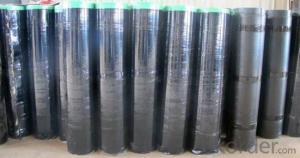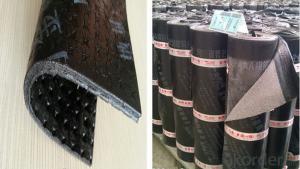SBS-Modified Bitumen Waterproof Membrane with Polyester Fiber and PE Film
- Loading Port:
- Tianjin
- Payment Terms:
- TT OR LC
- Min Order Qty:
- 1000 m²
- Supply Capability:
- 500000 m²/month
OKorder Service Pledge
OKorder Financial Service
You Might Also Like
SBS-PYPE is a waterproofing modified bitumen base sheet consisting of styrene-butadiene-styrene (SBS) modified asphalt reinforced with polyester fiber covering with polyethylene surfacing. There have two kinds of thickness: 3 mm, 4 mm。
We have two kinds of type in our company。They are I type and II type。They have differentt kinds of low temperature flexibility。
This type is 3mm thickness,type I。
If you want to know more about us,call the salesman of CNBM International Corporation (CNBM International) 。
CNBM INTERNATIONAL CORPORATION
Address:17th Floor, NO.4 Building, Zhuyu Business Center, Shouti South Road,Haidian District, Beijing,China
Post Code:100048
Tel:(86-10)68796888
Fax:(86-10) 68796668
Email:marketing@okorder.com, hr@okorder.com
- Q: Can a waterproofing membrane be used in permanent or long-term structures?
- Certainly, permanent or long-term structures can indeed make use of a waterproofing membrane. By creating a protective barrier against water infiltration, waterproofing membranes are perfectly suited for structures requiring extended safeguarding against moisture, such as buildings, bridges, tunnels, and underground constructions. These membranes are typically crafted from resilient materials like modified bitumen, PVC, EPDM, or polyurethane, which boast exceptional resistance to water, UV rays, and other environmental elements. A properly installed waterproofing membrane can significantly prolong the lifespan of a structure by thwarting water damage, mold growth, and structural decay. It is therefore highly advisable to utilize a waterproofing membrane in permanent or long-term structures to ensure their robustness and longevity.
- Q: Can a waterproofing membrane be applied on a vertical surface?
- Indeed, it is possible to apply a waterproofing membrane on a vertical surface. Vertical surfaces, including walls, foundations, and retaining walls, often benefit from the application of waterproofing membranes to safeguard against water infiltration and safeguard the underlying structures. These specialized membranes are formulated to adhere to vertical surfaces and establish a barrier that hinders water penetration. Commonly, they are applied utilizing various techniques such as spraying or rolling, and are suitable for both new construction and renovation endeavors. The utilization of a waterproofing membrane on a vertical surface is a reliable method to guarantee the long-lasting sturdiness and soundness of the edifice, preventing water-related harm.
- Q: Are there any specific safety precautions to consider when installing a waterproofing membrane?
- Yes, there are several safety precautions to consider when installing a waterproofing membrane. Firstly, it is important to ensure that all necessary personal protective equipment (PPE) is used by the installation team. This may include gloves, safety glasses, and appropriate footwear to prevent any injuries or exposure to hazardous materials. Additionally, it is crucial to work in a well-ventilated area to avoid inhalation of fumes or vapors emitted during the installation process. If working in a confined space, proper measures should be taken to ensure adequate ventilation and the use of proper respiratory protection if necessary. Furthermore, it is important to follow the manufacturer's instructions and guidelines for the specific waterproofing membrane being installed. This includes understanding any potential hazards associated with the product, such as flammability or toxicity, and taking necessary precautions to prevent accidents or exposure. Another safety consideration is to ensure that the installation area is properly prepared before beginning the process. This may involve removing any debris, cleaning the surface, and addressing any potential hazards or obstacles that could pose a risk to the installation team. Lastly, it is important to have a designated safety plan in place, including emergency procedures and first aid kits readily available in case of accidents or injuries. Regular safety inspections and monitoring throughout the installation process are also recommended to identify and address any potential safety risks promptly. By following these safety precautions, the installation of a waterproofing membrane can be carried out safely and effectively, minimizing the risk of accidents or injuries.
- Q: Are there any specific tools or equipment required for installing a waterproofing membrane?
- Yes, there are specific tools and equipment required for installing a waterproofing membrane. Some common tools include a trowel, utility knife, paint roller, brush, and caulking gun. Additionally, a heat gun or torch may be needed for certain types of membranes that require heat activation. It is important to follow the manufacturer's instructions and recommendations for the specific membrane being installed to ensure proper installation and effectiveness.
- Q: Can a waterproofing membrane be used on metal block surfaces?
- Metal block surfaces can indeed benefit from the use of a waterproofing membrane. These membranes are specifically designed to form a barrier against water and moisture, and they are versatile enough to be applied to various types of surfaces, including metal. By adhering to the metal surface, the membrane creates a protective layer that not only prevents water infiltration but also safeguards the metal against rust and corrosion. However, it is crucial to guarantee that the metal surface is thoroughly cleaned, dried, and appropriately prepared before the application of the waterproofing membrane. This preparation ensures optimal adhesion and effectiveness. For specific instructions on using a waterproofing membrane on metal block surfaces, it is highly recommended to consult a professional or refer to the manufacturer's guidelines.
- Q: Can a waterproofing membrane be used on aerated concrete block surfaces?
- Yes, a waterproofing membrane can be used on aerated concrete block surfaces. Aerated concrete blocks are known for their porous nature, which can make them prone to water penetration. Applying a waterproofing membrane on the surface of the blocks can help prevent water from seeping through and causing damage. The membrane forms a barrier that keeps water out while still allowing the blocks to breathe and release any trapped moisture. This helps to maintain the integrity and longevity of the aerated concrete block structures. However, it is important to ensure that the waterproofing membrane is specifically designed for use on aerated concrete blocks, as different materials require different types of membrane for optimal performance.
- Q: Can waterproofing membranes be used on metal roofs?
- Yes, waterproofing membranes can be used on metal roofs. These membranes are designed to create a protective barrier against water infiltration, and they can be applied to various roofing materials, including metal. Waterproofing membranes provide an effective solution to prevent leaks and extend the lifespan of metal roofs.
- Q: Are there any environmental considerations when using a waterproofing membrane?
- Yes, there are several environmental considerations when using a waterproofing membrane. One of the main concerns is the potential for harmful chemicals or materials to be used in the production of the membrane. Some waterproofing membranes may contain toxic substances such as volatile organic compounds (VOCs) or heavy metals, which can have detrimental effects on human health and the environment. Another consideration is the disposal of the membrane once it reaches the end of its life cycle. Many waterproofing membranes are not biodegradable and can contribute to landfill waste. Improper disposal can lead to environmental pollution and harm to ecosystems. Additionally, the production of waterproofing membranes often requires energy-intensive processes and the extraction of non-renewable resources. This can contribute to greenhouse gas emissions and the depletion of natural resources. To mitigate these environmental concerns, it is important to choose waterproofing membranes that have been manufactured using eco-friendly materials and processes. Look for products that are labeled as low VOC or free from hazardous substances. Additionally, consider using membranes that are recyclable or made from recycled materials to reduce waste generation. Proper disposal of the membrane at the end of its life cycle is also crucial, and options such as recycling or repurposing should be explored. Overall, it is essential to consider the environmental impact of waterproofing membranes and choose products and practices that minimize harm to the environment and promote sustainability.
- Q: Does a waterproofing membrane provide any protection against radon gas?
- No, a waterproofing membrane does not provide protection against radon gas. Radon gas is a radioactive gas that can seep through building materials, including waterproofing membranes. To protect against radon gas, specialized radon mitigation systems are required.
- Q: How does a waterproofing membrane handle settlement cracks?
- A waterproofing membrane is designed to handle settlement cracks by providing a continuous and flexible barrier that prevents water penetration. Settlement cracks occur when the ground beneath a structure shifts or settles, causing the foundation to crack. These cracks can allow water to seep into the building, leading to moisture damage and potential structural issues. When a settlement crack occurs, a waterproofing membrane can be applied to the affected area to create a seamless and watertight seal. The membrane acts as a protective layer that prevents water from entering through the crack and migrating into the building. It also helps to maintain the structural integrity of the foundation by reducing the chances of further cracking and deterioration. The flexibility of the waterproofing membrane is crucial in handling settlement cracks. It can accommodate the movement of the underlying structure without compromising its performance. As the ground settles or shifts, the membrane stretches and contracts, ensuring that the crack remains sealed and the waterproofing system remains intact. Additionally, some waterproofing membranes are equipped with self-healing properties. This means that if a settlement crack does occur, the membrane has the ability to reseal itself to maintain its watertight integrity. This self-healing capability can minimize the need for frequent repairs and maintenance, saving time and costs for property owners. Overall, a waterproofing membrane is an effective solution for handling settlement cracks. It provides a durable and flexible barrier that prevents water infiltration, protects against further damage, and helps to preserve the longevity of the structure.
Send your message to us
SBS-Modified Bitumen Waterproof Membrane with Polyester Fiber and PE Film
- Loading Port:
- Tianjin
- Payment Terms:
- TT OR LC
- Min Order Qty:
- 1000 m²
- Supply Capability:
- 500000 m²/month
OKorder Service Pledge
OKorder Financial Service
Similar products
Hot products
Hot Searches
Related keywords























